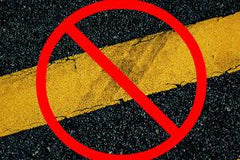Never Use Floor Marking Paint Again
 Safety floor marking paint has been a mainstay in most warehouses and factories for years. Although it has been used in the past for safety and organization, paint has a number of drawbacks:
Safety floor marking paint has been a mainstay in most warehouses and factories for years. Although it has been used in the past for safety and organization, paint has a number of drawbacks:
- Paint requires a shutdown of the floor before and after for a loss of 5 days or more
- Paint removal and reapplication can damage floors
- Paint can become unsightly quickly, requiring touch-ups as soon as 3 months after application
- Paint can't be moved easily to accommodate a lean manufacturing environment
- Paint emits noxious fumes
- Paint can only be applied within a specific temperature range.
Time
In any business, time is money. Time lost working impacts any company's bottom line. Although floor marking paint has been a mainstay in most warehouses and factories, businesses are switching to safety floor marking tape as they realize paint takes longer to apply and maintain.
Time required to prepare the floor and apply paint may result in up to 8 days of lost work. According to Rust-Oleum, surface preparation may include a concrete patching compound to repair small surface holes, cracks and pores, which requires a 72-hour dry time. Also recommended is a cleaning and etching solution for the concrete and a grinder to remove old paint. Concrete paint also requires a 48- to 72-hour dry time. Rustoleum also recommends an industrial or commercial sealant that requires up to an additional 72 hours to dry.
Blasting or chemical preparation is required to strip old paint and clean floors. These invasive methods may damage concrete floors, making concrete repair an essential step in subsequent applications of paint. Different paint colors, which are critical in a lean manufacturing environment, are even more time-consuming.
Preparation may take up to 3 full days, painting another 2 to 3, and sealing another 3.
After all that time and effort, paint in high-traffic areas can fade as soon as 3 months after application, requiring touch-up. Professional touch-ups take time and skill, so many factories have shop maintenance perform the task. These quick paint touch-ups can be bumpy and rough and result in safety issues, not to mention impact the plant's aesthetics.
Safety
Paint, concrete preparation chemicals, and sealants emit noxious fumes or chemicals that may sicken workers. Plant managers are faced with the option of painting during the day and worrying about worker complaints or hiring a painting crew to paint after hours.
Low VOC paints are available, but they are more expensive than regular paint and still emit some fumes.
Flexibility
More and more companies are implementing 5S methodology and lean manufacturing. Continuous improvement is a key aspect of lean manufacturing, which means floor markings may change frequently as new procedures and processes are implemented and new products and production machinery are introduced. Paint requires laborious preparation and application that may damage concrete floors.
Many types of paint can only be applied when the temperature is over 50° F, and none can be applied at temperatures below 32° F. This can result in OSHA violations, safety problems, and the inability to completely implement 5S methodology in cold environments.
The advent of 5S methodology and lean manufacturing has resulted in new technological innovations, including the use of bright, durable 5S floor marking tape. After exhaustive research, 5S Warehouse has chosen to distribute only Mighty Line floor tape, markers, and floor signs.
Test a sample of 5S Warehouse Mighty Line floor marking tape at your workplace!

